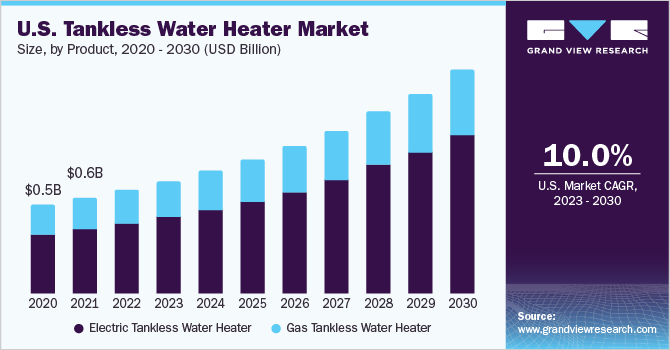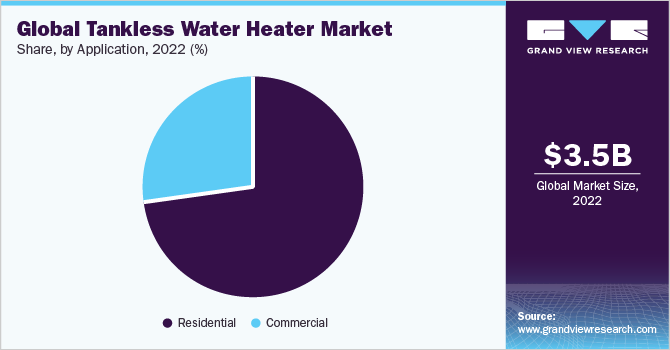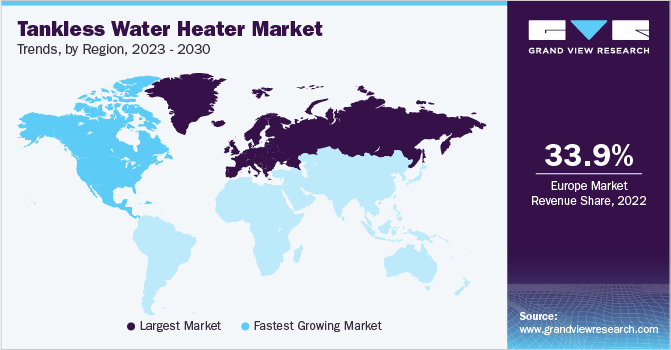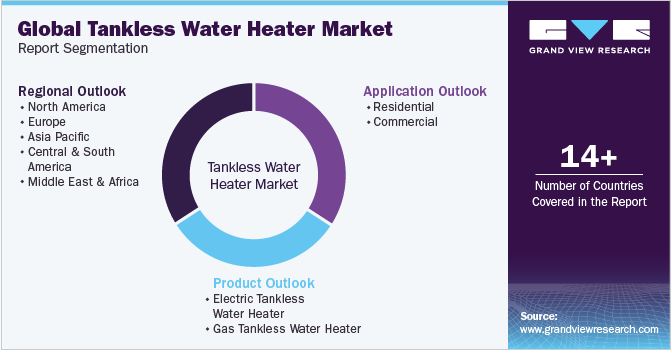- Home
- »
- Electronic & Electrical
- »
-
Tankless Water Heater Market Size & Share Report, 2030GVR Report cover
![Tankless Water Heater Market Size, Share & Trends Report]()
Tankless Water Heater Market Size, Share & Trends Analysis Report By Product (Electric Tankless Water Heater, Gas Tankless Water Heater), By Application (Residential, Commercial), By Region, And Segment Forecasts, 2023 - 2030
- Report ID: GVR-3-68038-635-6
- Number of Report Pages: 80
- Format: PDF, Horizon Databook
- Historical Range: 2017 - 2021
- Forecast Period: 2023 - 2030
- Industry: Consumer Goods
Report Overview
The global tankless water heater market size was valued at USD 3.49 billion in 2022 and is expected to grow at a compound annual growth rate (CAGR) of 8.7% from 2023 to 2030. Increasing consumer concerns over the sustainable use of energy is the main factor fueling demand for tankless water heaters. For instance, according to Energy.gov, the tankless water heater can be 24.0% to 34.0% more energy efficient as compared to the traditional product. A rapid increase in the adoption of these heaters among residential and commercial sectors as they are capable of saving space and energy is expected to boost the tankless water heater market growth during the forecast period.

Moreover, various tankless water heaters are equipped with energy star ratings, which make them eco-friendly and economical for buyers. Furthermore, these products generally cost more than conventional 40-gallon water heaters but usually have longer warranties, and they last longer as compared to traditional hot water heaters. In addition, a tankless water heater can save USD 100 - USD 200 on electric bills per year. An increasing replacement of the existing water heaters with tankless water heaters is expected to offer immense opportunities for the market during the forecast period.
COVID-19 had a negative impact on the global tankless water heater market. Due to the pandemic decline has been observed in the company revenue during 2020 in construction & building, transportation, oil & gas, automotive, and energy sectors owing to the globally imposed lockdown. This has declined the need for tankless water heaters in the commercial and residential sectors, which has hampered the growth of the market. Additionally, building and construction activities across the globe were on hold during the pandemic period due to the strict measure of social distancing, lack of labor, and raw material supply disruption.
Tankless water heaters are also known as demand-type or instantaneous water heaters, which provide hot water only as it is needed. They don't produce the standby energy losses associated with storage water heaters, which can save money. Typically, tankless water heaters provide hot water at a rate of 2-5 gallons (7.6-15.2 liters) per minute.
Companies are introducing technologically advanced tankless water heaters, which are expected to increase the adoption of these heaters in the upcoming years. For instance, in April 2019, Intellihot Inc., which is a clean technology IoT company and one of the leading manufacturers of commercial tankless water heaters, launched the Neuron Series of water heaters.
Commercial tankless water heaters are equipped with cellular Wi-Fi connectivity for remote monitoring of flow and water temperature. Moreover, these models are designed for schools, restaurants, & hotels and can fit in existing water connections, thereby eliminating re-piping and cutting installation time by half. Additionally, the majority of the companies, manufacturing these types of heaters, have special features available in some of their models. For instance, Stiebel Eltron has a patent on their Advanced Flow Control technology, which automatically decreases the flow rate when demand is high.
Product Insights
The electric tankless heaters segment dominated the market in 2022 and is expected to expand at the fastest CAGR of 8.9% during the forecast period. These types of heaters are easy to set up and require less installation cost. In addition, electric products usually last long and have low operating costs. Moreover, the innovative design of these heaters makes them feasible to install in small spaces and does not require any ventilation as compared to their gas counterparts.
Furthermore, electric products require less or no maintenance, whereas gas products require periodic maintenance by trained professionals. Such factors are anticipated to promote the utility of electric products as compared to their gas counterparts. Therefore, it is expected that the segment will grow at the fastest CAGR during the forecast period.
The gas tankless heaters segment is likely to develop with a CAGR of 8.4% during the forecast period. Gas tankless water heaters generally do not require the same upgrades to a home's basic services as electric tankless water heaters. In addition, gas tankless water heaters tend to have higher flow rates than electric ones. In a gas storage water heater, the pilot light heats the water in the tank so the energy isn't wasted. Thus, it is preferred over electric heaters and is likely to rise at a steady CAGR during the forecast period.
Application Insights
The residential segment dominated the market in 2022 and is expected to develop at the fastest CAGR of 8.8% during the forecast period. The growing adoption of energy-efficient and eco-friendly products including tankless water heaters is the main factor driving the demand for these products in the residential sector. Additionally, the increasing number of residential units, as a result of the growing middle-class population, especially in emerging economies such as India and China is expected to promote the adoption of these solutions during the forecast period.

In addition, the introduction of innovative products is expected to open new avenues. For instance, Rheem's Prestige models have EcoNet Smart Technology that provides Wi-Fi connectivity and add-on features, which offer system protection, control, and monetary savings.
The commercial segment is expected to expand with a CAGR of 8.5% during the forecast period. Increasing visibility of innovative products is expected to be a key factor driving demand for tankless water heaters during the forecast period. For instance, Intellihot’s tankless water heater provides continuous hot water when needed, thereby eliminating energy wastage and environmental impact as well as cutting down greenhouse gas emissions by more than 40.0%. Moreover, the tankless system comes with two years of 24/7 remote monitoring with serviceable parts shipped onsite proactively, thereby fueling the adoption of these systems in the commercial sector.
Regional Insights
North America is anticipated to expand at the fastest CAGR of 10.2% during the forecast period. Growing awareness related to ecological products, coupled with increasing product visibility, is a key factor driving demand for tankless water heaters during the forecast period. Moreover, the presence of prominent players in the region is expected to propel the demand for tankless water heaters in the upcoming years. Thus, the region is likely to develop at the fastest CAGR during the forecast period.

Europe accounted for the highest market share of around in 2022. This is due to the higher product adoption and shifting consumer preference for energy-efficient and economical products. Moreover, surging demand from the commercial sector including restaurants, hotels, and hospitals is expected to have a positive impact on market growth. In addition, the increasing adoption of tankless water heaters in countries such as Switzerland, Germany, and the U.K., is propelling demand in the region.
Key Companies & Market Share Insights
Manufacturers are focusing on integrating new & advanced technologies including smart control & monitoring features to enhance product service life and reduce maintenance time. In addition, major companies are focusing on enhancing their product portfolios with low price ranges that are suitable for diverse customer requirements.
-
In January 2023, Bosch Thermotechnology Corp. a leading provider of advanced heating and cooling water systems, launched - Tronic 4000 C for under-sink applications and Tronic 6100 c for whole-house applications under its electric tankless water heater category. These products provide 100% electric, on-demand hot water and reduces the requirement of storage tank.
-
In August 2022, Rinnai, a manufacturer of tankless water heaters launched the New RE Series Tankless Water Heater with Smart-Circ Intelligent Recirculation. The RE Series is compatible with the Wi-Fi module controller, to achieve scheduled recirculation or on-demand operations
-
In January 2022, Bradford White Corporation introduced the Kwick Shot, a dependable and simple-to-install tankless electric water heater available in thermostatic and non-thermostatic models to meet a range of water temperature needs in a variety of everyday applications
Some of the prominent players in the global tankless water heater market include:
-
A. O. Smith
-
Rheem Manufacturing Company
-
Rinnai Corporation
-
Bradford White Corporation
-
Robert Bosch LLC
-
EcoSmart Green Energy Products, Inc.
-
StiebelEltron Inc.
-
Takagi
-
Noritz America
-
Navien Inc.
Tankless Water Heater Market Report Scope
Report Attribute
Details
Market size value in 2023
USD 3.74 billion
Revenue forecast in 2030
USD 6.80 billion
Growth rate
CAGR of 8.7% from 2023 to 2030
Base year for estimation
2022
Historical data
2017 - 2021
Forecast period
2023 - 2030
Report updated
July 2023
Quantitative units
Revenue in USD billion and CAGR from 2023 to 2030
Report coverage
Revenue forecast, company ranking, competitive landscape, growth factors, and trends
Segments covered
Product, application, region
Regional scope
North America; Europe; Asia Pacific; Central & South America; Middle East & Africa
Country scope
U.S.; Canada; Mexico; U.K.; Germany; Italy; France; Spain; China; Japan; India; South Korea; Australia; Brazil; South Africa
Key companies profiled
A. O. Smith; Rheem Manufacturing Company; Rinnai Corporation; Bradford White Corporation; Robert Bosch LLC; EcoSmart Green Energy Products, Inc.; StiebelEltron Inc.; Takagi; Noritz America; Navien Inc.
Customization scope
Free report customization (equivalent up to 8 analysts’ working days) with purchase. Addition or alteration to country, regional & segment scope.
Pricing and purchase options
Avail customized purchase options to meet your exact research needs. Explore purchase options.
Global Tankless Water Heater Market Report Segmentation
This report forecasts revenue growth at global, regional & country levels and provides an analysis of the latest trends and opportunities in each of the sub-segment from 2017 to 2030. For this study, Grand View Research has segmented the global tankless water heater market report based on the product, application, and region:

-
Product Outlook (Revenue, USD Billion, 2017 - 2030)
-
Electric Tankless Water Heater
-
Gas Tankless Water Heater
-
-
Application Outlook (Revenue, USD Billion, 2017 - 2030)
-
Residential
-
Commercial
-
-
Regional Outlook (Revenue, USD Billion, 2017 - 2030)
-
North America
-
U.S.
-
Canada
-
Mexico
-
-
Europe
-
Germany
-
U.K.
-
France
-
Italy
-
Spain
-
-
Asia Pacific
-
China
-
Japan
-
India
-
South Korea
-
Australia
-
-
Central & South America
-
Brazil
-
-
Middle East & Africa
-
South Africa
-
-
Frequently Asked Questions About This Report
b. The global tankless water heater market size was estimated at USD 3.49 billion in 2022 and is expected to reach USD 3.74 billion in 2023.
b. The global tankless water heater market is expected to grow at a compounded growth rate of 8.7% from 2023 to 2030 to reach USD 6.80 billion by 2030.
b. The electric tankless water heater segment dominated the global tankless water heater market with a share of 69.1% in 2022. These types of heaters are easy to set up and require less installation cost. In addition, electric products usually last long and have low operating costs. Moreover, the innovative design of these heaters makes them feasible to install in small spaces and does not require any ventilation as compared to their gas counterparts.
b. Some key players operating in the global tankless water heater market include A. O. Smith; Rheem Manufacturing Company; Rinnai Corporation; Bradford White Corporation; Robert Bosch LLC; EcoSmart Green Energy Products, Inc.; Stiebel Eltron Inc.; Takagi; Noritz America; and Navien Inc.
b. Key factors that are driving the tankless water heater market growth include increasing consumer concerns over sustainable use of energy and increasing launches of technologically advanced products.
Share this report with your colleague or friend.
![gvr icn]()
NEED A CUSTOM REPORT?
We can customize every report - free of charge - including purchasing stand-alone sections or country-level reports, as well as offer affordable discounts for start-ups & universities. Contact us now
![Certified Icon]()
We are GDPR and CCPA compliant! Your transaction & personal information is safe and secure. For more details, please read our privacy policy.
We are committed towards customer satisfaction, and quality service.
"The quality of research they have done for us has been excellent."





